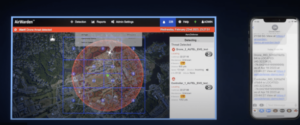 AeroDefense Announces Remote ID Integration for Detection Systems, New Remote ID Receiver
AeroDefense Announces Remote ID Integration for Detection Systems, New Remote ID Receiver
DRONELIFE Staff Writer Ian M. Crosby
aero defense provides remote ID integration for AirWarden™ drone and pilot detection systems and a new AirWarden Remote ID Receiver: Compact and affordable remote ID broadcast receiver. Federal Aviation Administration remote ID regulations require drones in flight to broadcast identification and location information that anyone can receive. Newly manufactured drones must now comply with this rule, while existing drones must comply by September 2023.
Usage:
https://www.youtube.com/watch?v=DRlwce Cyfdg
A member of the Smart Airport and Aviation Partnership’s (SAAP) initial flightPlan Aviation Accelerator cohort, AeroDefense developed the AirWarden Remote ID Receiver with support from research grants from SAAP and the Atlantic County Economic Alliance. Program Director Carole Mattesich said, “AeroDefense has embraced the opportunities for collaboration and innovation offered by SAAP, and we hope that more graduates will achieve the same success.
The system receives Remote ID broadcasts and the AirWarden command console alerts users to airspace violations by Remote ID compliant drones. Key information such as drone type, speed and drone/pilot position are provided in real-time, and all other remote ID information obtained during detection is available on-demand. Organizations monitoring multiple sites can do so from a single screen, receiving visual alerts when drone incidents occur in specific areas of interest.
AirWarden for drone detection
“The revolutionary AirWarden Remote ID Receiver not only receives Remote ID broadcasts, but also detects publicly transmitting WiFi drones,” said Linda Ziemba, founder and CEO of AeroDefense. . “Affordable receivers make drone detection practical in critical locations such as schools in countries that are incredibly vulnerable to violence. , we can dispatch emergency response vehicles with more powerful AirWarden sensors to detect and track non-transmitting drones and connect them to AirWarden remote ID receivers if necessary.”
Violators can interfere with remote ID signing, disable broadcast modules, and fly home-grown devices. Therefore, organizations with high drone threat levels and low risk tolerance need a solution that can receive remote ID broadcasts and identify non-broadcasting drones, regardless of make or model.
AeroDefense’s AirWarden full suite Fixed and mobile drone detection solutions include AirWarden remote ID receivers, AirWarden sensors (fixed or mobile), and AirWarden direction finding modules, which are expected to enter the beta testing phase in Q3 2023.
read more:
Ian attended Dominican University in California and graduated with a BA in English in 2019. With his lifelong passion for writing and storytelling and keen interest in technology, he now contributes to his DroneLife as a staff writer.
Miriam McNabb, editor-in-chief of DRONELIFE and CEO of professional drone services marketplace JobForDrones, is a fascinating observer of the emerging drone industry and drone regulatory environment. With her 3,000+ articles focused on the commercial drone space, Miriam is an international speaker and recognized figure in the industry. Miriam has a degree from the University of Chicago and high tech she has over 20 years of experience in sales and marketing new technologies.
For drone industry consulting or writing, please email Miriam.
twitter:@spaldingbarker
Subscribe to Drone Life here.
![Drone Detection: AeroDefense Launches Low Cost, Low Profile Remote ID Receiver [VIDEO]](https://uavify.com/wp-content/uploads/2023/04/Screen-Shot-2023-04-21-at-1.00.25-PM-1024x427.png)